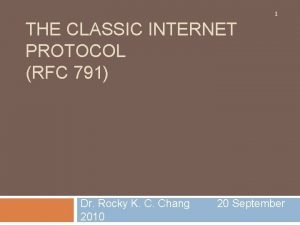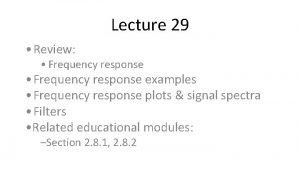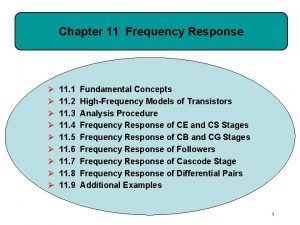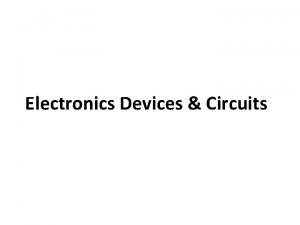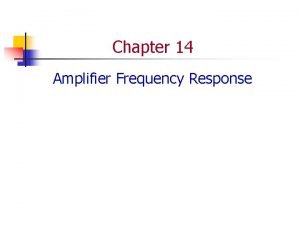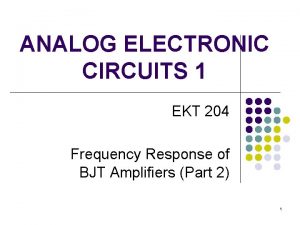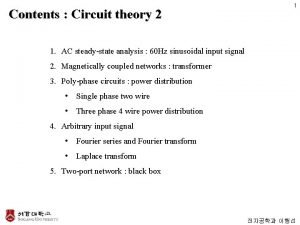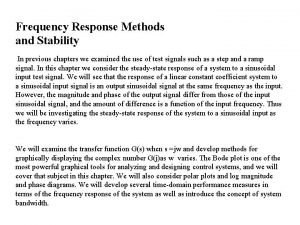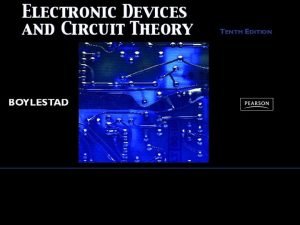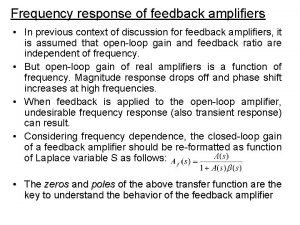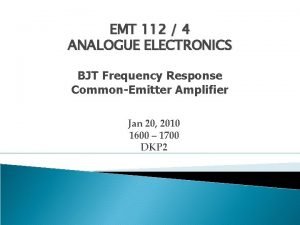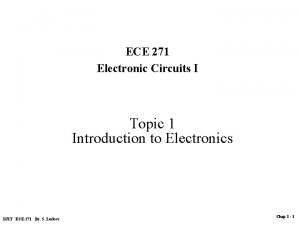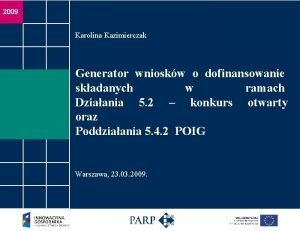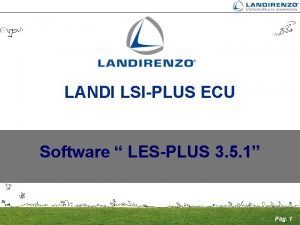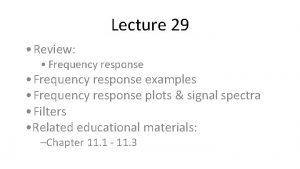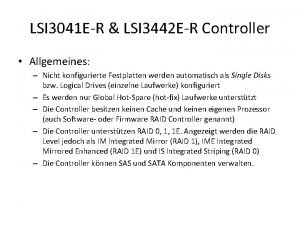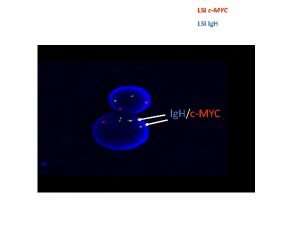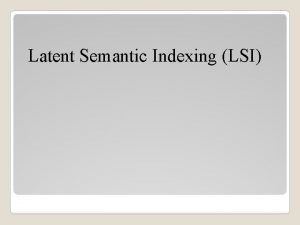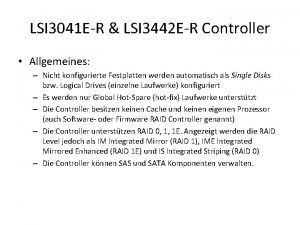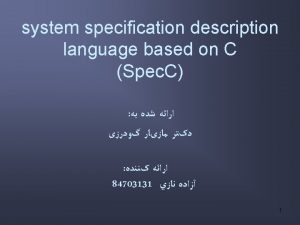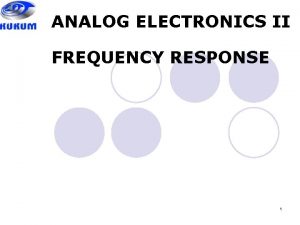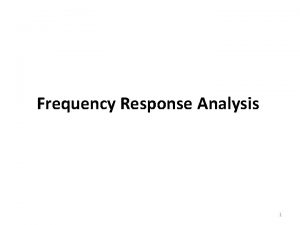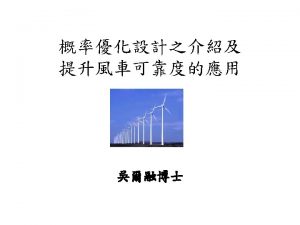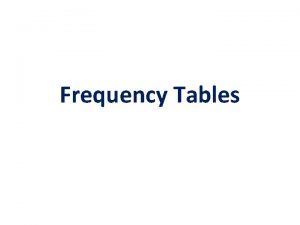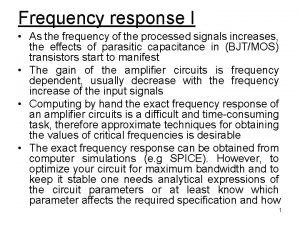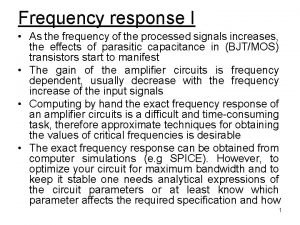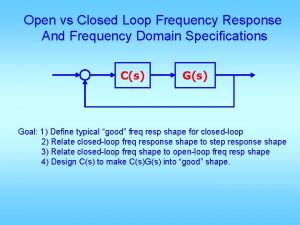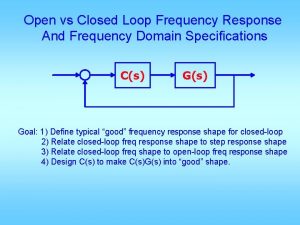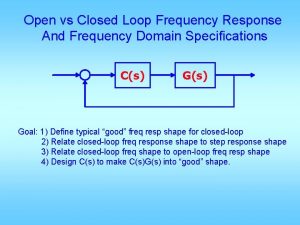18 791 Lecture 7 FREQUENCY RESPONSE OF LSI


![Review - Difference equations and Ztransforms characterizing LSI systems x[n] h[n] y[n] n Many Review - Difference equations and Ztransforms characterizing LSI systems x[n] h[n] y[n] n Many](https://slidetodoc.com/presentation_image_h2/93058a109fe3011f9fe2ae4676be6ed7/image-3.jpg)
























![Zeros of linear phase systems n [add discussion on zero locations of LP systems] Zeros of linear phase systems n [add discussion on zero locations of LP systems]](https://slidetodoc.com/presentation_image_h2/93058a109fe3011f9fe2ae4676be6ed7/image-28.jpg)


- Slides: 30

18 -791 Lecture #7 FREQUENCY RESPONSE OF LSI SYSTEMS Richard M. Stern Department of Electrical and Computer Engineering Carnegie Mellon University Pittsburgh, Pennsylvania 15213 Phone: +1 (412) 268 -2535 FAX: +1 (412) 268 -3890 rms@cs. cmu. edu http: //www. ece. cmu. edu/~rms September 19, 2000

Introduction n Last week we discussed the Z-transform at length, including the unit sample response, ROC, inverse Z-transforms and comparison to the DTFT and difference equations n Today we will discuss the frequency response of LSI systems and how it relates to the system function in Z-transform n Specifically we will … – Relate magnitude and phase of DTFT to locations of poles and zeros in z-plane – Discuss several important special cases: » All-pass systems » Minimum/maximum-phase systems » Linear phase systems Carnegie Mellon Slide 2 ECE Department
![Review Difference equations and Ztransforms characterizing LSI systems xn hn yn n Many Review - Difference equations and Ztransforms characterizing LSI systems x[n] h[n] y[n] n Many](https://slidetodoc.com/presentation_image_h2/93058a109fe3011f9fe2ae4676be6ed7/image-3.jpg)
Review - Difference equations and Ztransforms characterizing LSI systems x[n] h[n] y[n] n Many LSI systems are characterized by difference equations of the form n They produce system functions of the form n Comment: This notation is a little different from last week’s (but consistent with the text in Chap, 5) Carnegie Mellon Slide 3 ECE Department

Difference equations and Z-transforms characterizing LSI systems (cont. ) n Comments: – LSI systems characterized by difference equations produce z-transforms that are ratios of polynomials in z or z-1 – The zeros are the values of z that cause the numerator to equal zero, and the poles are the values of z that cause the denominator polynomial to equal zero Carnegie Mellon Slide 4 ECE Department

Discrete-time Fourier transforms and the Z-transform n Recall that the DTFT is obtained by evaluating the z-transform along the contour n The DTFT is generally complex and typically characterized by its magnitude and phase: Carnegie Mellon Slide 5 ECE Department

Obtaining the magnitude and phase of the DTFT by factoring the z-transform n Factoring the z-transform: n Comment: The constants and are the zeros and poles of the system respectively Carnegie Mellon Slide 6 ECE Department

So what do those terms mean, anyway? n Convert into a polynomial in z by multiplying numerator and denominator by largest power of z: n Now consider one of the numerator terms, Note that the vector (z-ck) is the length of line from the zero to the current value of z or the distance from the zero to the unit circle. Carnegie Mellon Slide 7 ECE Department

Finding the magnitude of the DTFT n Magnitude: n Comment: The magnitude is the product of magnitudes from zeros divided by product of magnitudes from poles Carnegie Mellon Slide 8 ECE Department

Finding the phase of the DTFT n Phase: n Comment: The magnitude is the sum of the angles from the zeros minus the sums of the angles from the poles Carnegie Mellon Slide 9 ECE Department

Example 1: Unit time delay n Pole-zero pattern: Carnegie Mellon Frequency response: Slide 10 ECE Department

Example 2: Decaying exponential sample response n Pole-zero pattern: Carnegie Mellon Frequency response: Slide 11 ECE Department

Example 3: Notch filter n Pole-zero pattern: Carnegie Mellon Frequency response: Slide 12 ECE Department

Summary (first half) n The DTFT is obtained by evaluating the z-transform along the unit circle n As we walk along the unit circle, – The magnitude of the DTFT is proportional of the product of the distances from the zeros divided by the product of the distances from the poles – The phase of the DTFT is (within additive constants) the sum of the angles from the zeros minus the sum of the angles from the poles n After the break: – Allpass systems – Minimum-phase and maximum-phase systems – Linear-phase systems Carnegie Mellon Slide 13 ECE Department

Special types of LSI systems n We can get additional insight about the frequency-response behavior of LSI systems by considering three special cases: – Allpass systems – Systems with minimum or maximum phase – Linear-phase systems Carnegie Mellon Slide 14 ECE Department

All-pass systems n Consider an LSI system with system function with a complex …. . n Let – Then there is a pole at – And a zero at n Comment: We refer to this configuration as “mirror image” poles and zeros Carnegie Mellon Slide 15 ECE Department

Frequency response of all-pass systems n Obtaining magnitude of frequency response directly: Carnegie Mellon Slide 16 ECE Department

Frequency response of all-pass systems n All-pass systems have mirror-image sets of poles and zeros n All-pass systems have a frequency response with constant magnitude Carnegie Mellon Slide 17 ECE Department

System functions with the same magnitude can have more than one phase function n Consider two systems: System 1: pole at. 75, zero at. 5 System 2: pole at. 75, zero at 2 n Comment: System 2 can be obtained by cascading System 1 with an all-pass system with a pole at. 5 and a zero at 2. Hence the two systems have the same magnitude. Carnegie Mellon Slide 18 ECE Department

But what about the two phase responses? Response of System 1: Response of System 2: n Comment: Systems have same magnitude, but System 2 has much greater phase shift Carnegie Mellon Slide 19 ECE Department

General comments on phase responses n System 1 has much less phase shift than System 2; this is generally considered to be good n System 1 has its zero inside unit circle; System 2 has zero its zero outside the unit circle n A system is considered to be of “minimum phase” if all of its zeros and all poles lie inside the unit circle n A system is considered to be of “maximum phase” if all of its zeros and all poles lie outside the unit circle n Systems with more than one zero might have neither minimum nor maximum phase Carnegie Mellon Slide 20 ECE Department

A digression: Symmetry properties of DTFTs n Recall from DTFT properties: n If then and. . . Carnegie Mellon Slide 21 ECE Department

Consequences of Hermitian symmetry n If Then And Carnegie Mellon Slide 22 ECE Department

Zero phase systems n Consider an LSI system with an even unit sample response: n DTFT is n Comments: – Frequency response is real, so system has “zero” phase shift – This is to be expected since unit sample response is real and even Carnegie Mellon Slide 23 ECE Department

Linear phase systems n Now delay the system’s sample response to make it causal: n DTFT is now n Comment: – Frequency response now exhibits linear phase shift Carnegie Mellon Slide 24 ECE Department

An additional comment or two n The system on the previous page exhibits linear phase shift n This is also reasonable, since the corresponding sample response can be thought of as a zero-phase sample response that undergoes a time shift by two samples (producing a linear phase shift in the frequency domain) n Another way to think about this is as a sample response that is even symmetric about the sample n=2 n Linear phase is generally considered to be more desirable than non-linear phase shift n If a linear-phase system is causal, it must be finite in duration. (The current example has only 5 nonzero samples. ) Carnegie Mellon Slide 25 ECE Department

Another example of a linear phase systems n Now let’s consider a similar system but with an even number of sample points: n DTFT is Carnegie Mellon Slide 26 ECE Department

Comments on the last system n The system on the previous page also exhibits linear phase shift n In this case the corresponding sample response can be thought of as a zero-phase sample response that undergoes a time shift by 2. 5 samples n In this case the unit sample response is symmetric about the “point” n=2. 5 n This type of system exhibits “generalized linear phase”, because the unit sample response is symmetric about a location that is between two integers Carnegie Mellon Slide 27 ECE Department
![Zeros of linear phase systems n add discussion on zero locations of LP systems Zeros of linear phase systems n [add discussion on zero locations of LP systems]](https://slidetodoc.com/presentation_image_h2/93058a109fe3011f9fe2ae4676be6ed7/image-28.jpg)
Zeros of linear phase systems n [add discussion on zero locations of LP systems] Carnegie Mellon Slide 28 ECE Department

Four types of linear-phase systems n Oppenheim and Schafer refer to four types systems with generalized linear phase. All have sample points that are symmetric about its midpoint. – Type I: Odd number of samples, even symmetry – Type II: Even number of samples, even symmetry – Type III: Odd number of samples, odd symmetry – Type IV: Even number of samples, odd symmetry Carnegie Mellon Slide 29 ECE Department

Summary of second half of lecture n All-pass systems have poles and zeros in “mirror-image” pairs n Minimum phase causal and stable systems have all zeros (as well as all poles) inside the unit circle n Maximum phase causal and stable systems have all zeros and all poles outside the unit circle n Linear phase systems have unit sample responses that are symmetric about their midpoint (which may lie between two sample points Carnegie Mellon Slide 30 ECE Department
 Rfc791
Rfc791 Bodrogkeresztúri riolittufa
Bodrogkeresztúri riolittufa A word 791
A word 791 01:640:244 lecture notes - lecture 15: plat, idah, farad
01:640:244 lecture notes - lecture 15: plat, idah, farad What is joint relative frequency
What is joint relative frequency Relative frequency bar chart
Relative frequency bar chart How to calculate relative frequency
How to calculate relative frequency Joint frequency vs marginal frequency
Joint frequency vs marginal frequency Constant phase difference
Constant phase difference Marginal relative frequency
Marginal relative frequency Vmax=aw
Vmax=aw Rl circuit frequency response
Rl circuit frequency response Et 212
Et 212 Source follower frequency response
Source follower frequency response Multistage amplifier circuit
Multistage amplifier circuit Formula for cutoff frequency
Formula for cutoff frequency Frequency response cbe
Frequency response cbe Inductor frequency response
Inductor frequency response High frequency transistor amplifier
High frequency transistor amplifier Difference between pulse doppler radar and mti radar
Difference between pulse doppler radar and mti radar Frequency response methods and stability
Frequency response methods and stability Fet frequency response
Fet frequency response Frequency response of feedback amplifier
Frequency response of feedback amplifier Rince
Rince Thevenin and norton
Thevenin and norton Lsi logowanie parp
Lsi logowanie parp Landi lsi
Landi lsi Lsi parp
Lsi parp Lsi
Lsi Lsi
Lsi Lokalny system informatyczny
Lokalny system informatyczny
